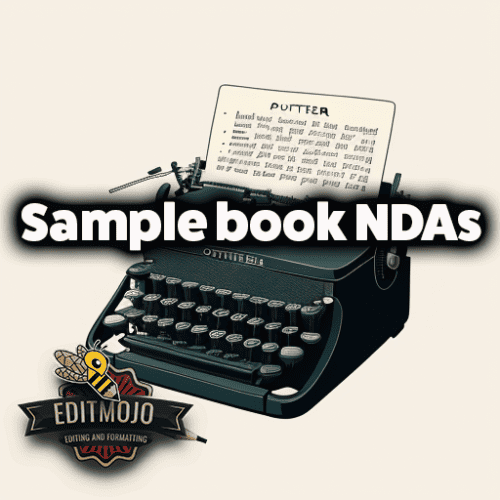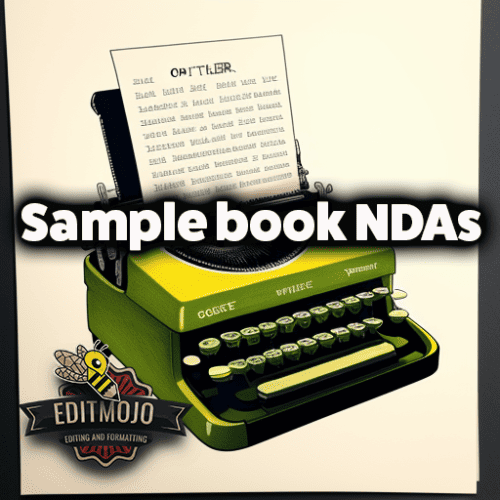Sample book NDAs
Sample book NDAs. The secrets we hold are the stories untold. But what happens when these secrets, these stories, need the cover of legal protection? Enter the realm of Non-Disclosure Agreements in the book publishing industry, and let’s unravel their ins and outs together.
(Copy and Paste Sample at End of Post)
Key Takeaway Table
| Key Point | Takeaway |
|---|---|
| Understanding NDAs | NDAs are legally binding contracts that ensure sensitive information in a book remains confidential until publication. |
| Book NDA Need | NDAs protect authors’ intellectual property and publishers’ strategic plans from being prematurely revealed. |
| Elements of NDAs | A typical NDA should identify involved parties, define confidential information, scope, duration, exceptions, and potential breach consequences. |
| Types of NDAs | The two main types are Unilateral (one party disclosing to another) and Mutual (both parties sharing confidential information). |
| Real-world cases | NDAs have been instrumental in high-profile releases like “Go Set a Watchman” by Harper Lee. |
| Legal Implications | Breaching an NDA can lead to financial penalties and damage to professional relationships. |
| Expert Advice | Always consult a legal professional when dealing with NDAs to avoid common pitfalls and ensure your interests are protected. |
| NDAs in the Future | The digital age is likely to bring about changes in the nature of NDAs, especially in digital and electronic distribution. |
Understanding NDAs in the Publishing Industry
To begin with, let’s decipher what a Non-Disclosure Agreement (NDA) is. Simply put, an NDA is a legally binding contract that keeps a lid on sensitive information, making sure it stays out of the public eye. In the world of book publishing, NDAs serve as the guardians of ideas, concepts, and literary content.
Why, you might wonder, are NDAs pivotal in publishing? Their necessity emanates from the unique nature of the publishing process, which often involves many hands in the proverbial pot. From authors and publishers to ghostwriters, editors, and marketers – all these individuals come into contact with the book before its release, making the confidentiality of information paramount.
The introduction of NDAs into the publishing landscape can be traced back to the late 20th century when competition began to skyrocket and the premature leakage of a book’s content could lead to calamitous results. One such notable case is J.K. Rowling’s “Harry Potter and the Deathly Hallows,” where tight-lipped NDAs played a significant role in keeping the book’s ending a well-guarded secret.
Reasons Why You May Need a Book NDA
For an author, an NDA is akin to a protective shield, ensuring that their intellectual property isn’t prematurely revealed or worse, stolen. The art of storytelling often lies in the surprise factor, and an NDA helps preserve this element, ensuring that plot twists and key moments are revealed at the right time, to the right audience.
For publishers and third-party collaborators, NDAs help to safeguard strategic plans like book launches, marketing strategies, and unique selling points from prying eyes. It’s like a cook keeping their secret recipe under wraps until the dish is served.

Essential Elements of a Book NDA
An NDA might seem like an intimidating document, but in essence, it comprises a few key elements. Let’s break it down:
- Identification of the Parties Involved: Just like in a mystery novel, knowing the characters is crucial. This section clearly identifies who’s bound by the agreement.
- Definition of Confidential Information: What’s the secret that needs to be kept? This portion defines the confidential material.
- Scope and Duration of the Confidentiality Obligation: This outlines how long the secret needs to be kept and how the information can (or can’t) be used.
- Exceptions to the Confidentiality Obligations: Every rule has exceptions. This section clarifies situations where information can be disclosed without breaching the agreement.
- Consequences of a Breach: Just like a plot twist in a thriller, this part outlines the repercussions if the agreement is broken.
Types of NDAs and their Application in Book Publishing
In the world of NDAs, one size doesn’t fit all. Primarily, we have two types: Unilateral and Mutual NDAs.
A Unilateral NDA, much like a monologue in a play, involves one party disclosing information to another, with the latter being obliged to keep it confidential. A classic example here could be an author sharing a manuscript with a potential publisher.
A Mutual NDA, on the other hand, is like a dialog, where both parties share confidential information and agree to protect it. This type could be employed when authors co-write a book or when a publisher and a marketing agency strategize a book launch.

Real-World Cases where NDAs Played a Significant Role in Book Publishing
The power of NDAs is palpable in several high-profile book releases. For instance, Harper Lee’s “Go Set a Watchman” was kept under wraps using stringent NDAs. The secrecy stoked anticipation and led to robust sales, illustrating the value of a well-executed NDA.
Legal Implications of Book NDAs (Sample book NDAs)
Breaching an NDA can have serious consequences, ranging from financial penalties to irreparable damage to professional relationships. It’s much like releasing a spoiler – it ruins the story for everyone and leaves the spoilsport ostracized.
Expert Advice on Crafting and Implementing Book NDAs
As author John Le Carré once said, ‘A desk is a dangerous place from which to view the world.’ Hence, seeking legal advice when dealing with NDAs is crucial. Remember, each NDA should be tailored to your specific situation and needs – a generic template won’t always cover your bases.
Common mistakes to avoid include failing to clearly define confidential information, not specifying the term of the agreement, and neglecting to plan for the possibility of a breach.

How to Respond if Presented with an NDA
If you’re an author or collaborator handed an NDA, don’t panic. It’s important to read and understand the terms before signing. It’s equally vital to negotiate any clauses that you’re uncomfortable with. As in any good negotiation, the goal is a win-win situation.
Looking Ahead: The Future of NDAs in Book Publishing
In a rapidly changing world, NDAs will continue to evolve. With the advent of digital publishing and AI-generated content, we’ll likely see an increasing need for NDAs that cover these new realms.
A well-crafted NDA can be a vital tool in the publishing process. But like any tool, it’s essential to understand its use, scope, and implications. With this understanding, authors, publishers, and collaborators alike can safeguard their creative endeavours and navigate the publishing world with confidence.
SAMPLE NON-DISCLOSURE AGREEMENT
THIS AGREEMENT (the “Agreement”) made this ____ day of , 20_, (the “Effective Date”) is entered into by and between _________________ (the “Disclosing Party”), and _________________ (the “Receiving Party”).
WHEREAS the Disclosing Party possesses certain non-public and confidential information related to a book, the details of which are more specifically set forth in Exhibit A attached hereto (the “Confidential Information”);
WHEREAS the Receiving Party understands that the Disclosing Party wishes to maintain the confidentiality of the Confidential Information;
NOW, THEREFORE, in consideration of the mutual covenants contained herein and for other good and valuable consideration, the receipt and sufficiency of which is hereby acknowledged, the parties agree as follows:
- Confidential Information: The Receiving Party understands that the Confidential Information includes, but is not limited to, information concerning the Disclosing Party’s unpublished book including drafts, summaries, marketing plans, launch dates, distribution arrangements and any other related materials.
- Non-Disclosure: The Receiving Party agrees to use the Confidential Information solely in connection with the current or contemplated business relationship between the parties and will not disclose the Confidential Information to any third party without the prior written consent of the Disclosing Party.
- Exceptions: The obligations and restrictions do not apply to that part of the Confidential Information that: (a) was known to the Receiving Party at the time of disclosure, (b) is, or becomes, available to the public through no breach of this Agreement, (c) is rightfully received from a third party not in breach of any obligation of confidentiality, or (d) is independently developed by the Receiving Party.
- Term: This Agreement and Receiving Party’s duty to hold the Confidential Information in confidence shall remain in effect until ___ years after the Effective Date or until the Disclosing Party sends the Receiving Party written notice releasing it from this Agreement.
- Breach: The Receiving Party agrees that any violation or threatened violation of this Agreement will cause irreparable injury to the Disclosing Party, entitling the Disclosing Party to seek injunctive relief in addition to all legal remedies without the requirement of posting a bond or other security.
- Miscellaneous: This Agreement sets forth the entire agreement and understanding between the parties relating to the subject matter herein and merges all prior discussions between them. This Agreement shall be governed by and interpreted in accordance with the laws of _____________ (jurisdiction).
Disclosing Party:
Name
Receiving Party:
Name
Top Five Questions and Answers Table
| Question | Answer |
|---|---|
| What is a Non-Disclosure Agreement (NDA) in the context of book publishing? | An NDA is a legally binding contract that ensures sensitive information about a book remains confidential until publication. |
| Why are NDAs important in the publishing industry? | NDAs protect authors’ intellectual property and publishers’ strategic plans from being prematurely revealed or stolen. |
| What are the key elements of a book NDA? | A typical NDA should identify the parties involved, define what is confidential, and outline the scope, duration, exceptions, and potential consequences of a breach. |
| What are the types of NDAs? | The two main types are Unilateral (one party discloses to another) and Mutual (both parties share confidential information). |
| What are the potential consequences of breaching an NDA? | Consequences can range from financial penalties to damage to professional relationships and reputational harm. |
